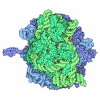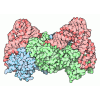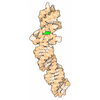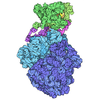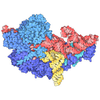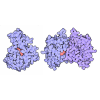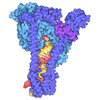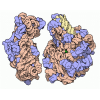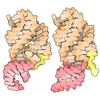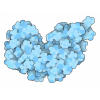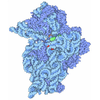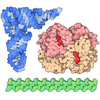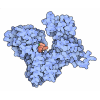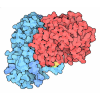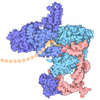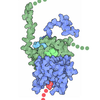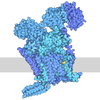+ Open data
Open data
- Basic information
Basic information
| Entry | Database: PDB / ID: 9kwc | ||||||
|---|---|---|---|---|---|---|---|
| Title | Cas12a-PCPS-light | ||||||
 Components Components |
| ||||||
 Keywords Keywords | header DNA BINDING PROTEIN/RNA / Cas12a-PCPS-dark / DNA BINDING PROTEIN/RNA / header DNA BINDING PROTEIN-RNA complex | ||||||
| Function / homology |  Function and homology information Function and homology information: / CRISPR-associated endonuclease Cpf1 PI domain / : / CRISPR-associated endonuclease Cpf1 REC2 domain / CRISPR-associated endonuclease Cas12a / Cas12a, REC1 domain / Cas12a, RuvC nuclease domain / Cas12a, nuclease domain / Alpha helical recognition lobe domain / Nuclease domain / RuvC nuclease domain Similarity search - Domain/homology | ||||||
| Biological species |  Lachnospiraceae bacterium ND2006 (bacteria) Lachnospiraceae bacterium ND2006 (bacteria)synthetic construct (others) | ||||||
| Method | ELECTRON MICROSCOPY / single particle reconstruction / cryo EM / Resolution: 2.9 Å | ||||||
 Authors Authors | Zhang, M.F. | ||||||
| Funding support |  China, 1items China, 1items
| ||||||
 Citation Citation |  Journal: Nat Commun / Year: 2025 Journal: Nat Commun / Year: 2025Title: Scalable modulation of CRISPR‒Cas enzyme activity using photocleavable phosphorothioate DNA. Authors: Menglu Hu / Bingni Zhang / Yuanyue Shan / Feng Cao / Yihui Wang / Weiwei Qi / Xue Wang / Yuting Shen / Xinyi Guo / Mengmeng Zhang / Tian Tian / Wei Xie / Mingfeng Zhang / Fang Liang / ...Authors: Menglu Hu / Bingni Zhang / Yuanyue Shan / Feng Cao / Yihui Wang / Weiwei Qi / Xue Wang / Yuting Shen / Xinyi Guo / Mengmeng Zhang / Tian Tian / Wei Xie / Mingfeng Zhang / Fang Liang / Duanqing Pei / Xiaoming Zhou /  Abstract: The regulation of CRISPR‒Cas activity is critical for developing advanced biotechnologies. Optical control of CRISPR‒Cas system activity can be achieved by modulation of Cas proteins or guide RNA ...The regulation of CRISPR‒Cas activity is critical for developing advanced biotechnologies. Optical control of CRISPR‒Cas system activity can be achieved by modulation of Cas proteins or guide RNA (gRNA), but these approaches either require complex protein engineering modifications or customization of the optically modulated gRNAs according to the target. Here, we present a method, termed photocleavable phosphorothioate DNA (PC&PS DNA)-mediated regulation of CRISPR‒Cas activity (DNACas), that is versatile and overcomes the limitations of conventional methods. In DNACas, CRISPR‒Cas activity is silenced by the affinity binding of PC&PS DNA and restored through light-triggered chemical bond breakage of PC&PS DNA. The universality of DNACas is demonstrated by adopting the PC&PS DNA to regulate various CRISPR‒Cas enzymes, achieving robust light-switching performance. DNACas is further adopted to develop a light-controlled one-pot LAMP-BrCas12b detection method and a spatiotemporal gene editing strategy. We anticipate that DNACas could be employed to drive various biotechnological advances. | ||||||
| History |
|
- Structure visualization
Structure visualization
| Structure viewer | Molecule:  Molmil Molmil Jmol/JSmol Jmol/JSmol |
|---|
- Downloads & links
Downloads & links
- Download
Download
| PDBx/mmCIF format |  9kwc.cif.gz 9kwc.cif.gz | 484.8 KB | Display |  PDBx/mmCIF format PDBx/mmCIF format |
|---|---|---|---|---|
| PDB format |  pdb9kwc.ent.gz pdb9kwc.ent.gz | 393.6 KB | Display |  PDB format PDB format |
| PDBx/mmJSON format |  9kwc.json.gz 9kwc.json.gz | Tree view |  PDBx/mmJSON format PDBx/mmJSON format | |
| Others |  Other downloads Other downloads |
-Validation report
| Summary document |  9kwc_validation.pdf.gz 9kwc_validation.pdf.gz | 1.5 MB | Display |  wwPDB validaton report wwPDB validaton report |
|---|---|---|---|---|
| Full document |  9kwc_full_validation.pdf.gz 9kwc_full_validation.pdf.gz | 1.6 MB | Display | |
| Data in XML |  9kwc_validation.xml.gz 9kwc_validation.xml.gz | 57.9 KB | Display | |
| Data in CIF |  9kwc_validation.cif.gz 9kwc_validation.cif.gz | 81.8 KB | Display | |
| Arichive directory |  https://data.pdbj.org/pub/pdb/validation_reports/kw/9kwc https://data.pdbj.org/pub/pdb/validation_reports/kw/9kwc ftp://data.pdbj.org/pub/pdb/validation_reports/kw/9kwc ftp://data.pdbj.org/pub/pdb/validation_reports/kw/9kwc | HTTPS FTP |
-Related structure data
| Related structure data |  62607MC  9kwbC M: map data used to model this data C: citing same article ( |
|---|---|
| Similar structure data | Similarity search - Function & homology  F&H Search F&H Search |
- Links
Links
- Assembly
Assembly
| Deposited unit | 
|
|---|---|
| 1 |
|
- Components
Components
| #1: Protein | Mass: 143489.859 Da / Num. of mol.: 1 Source method: isolated from a genetically manipulated source Source: (gene. exp.)  Lachnospiraceae bacterium ND2006 (bacteria) Lachnospiraceae bacterium ND2006 (bacteria)Production host:  |
|---|---|
| #2: RNA chain | Mass: 8041.781 Da / Num. of mol.: 1 / Source method: obtained synthetically / Source: (synth.) synthetic construct (others) |
| Has protein modification | N |
-Experimental details
-Experiment
| Experiment | Method: ELECTRON MICROSCOPY |
|---|---|
| EM experiment | Aggregation state: PARTICLE / 3D reconstruction method: single particle reconstruction |
- Sample preparation
Sample preparation
| Component | Name: Cas12a-PCPS-dark / Type: COMPLEX / Entity ID: all / Source: MULTIPLE SOURCES |
|---|---|
| Source (natural) | Organism:  Lachnospiraceae bacterium ND2006 (bacteria) Lachnospiraceae bacterium ND2006 (bacteria) |
| Source (recombinant) | Organism:  |
| Buffer solution | pH: 7.4 |
| Specimen | Embedding applied: NO / Shadowing applied: NO / Staining applied: NO / Vitrification applied: YES |
| Vitrification | Cryogen name: ETHANE |
- Electron microscopy imaging
Electron microscopy imaging
| Microscopy | Model: FEI MORGAGNI |
|---|---|
| Electron gun | Electron source:  FIELD EMISSION GUN / Accelerating voltage: 300 kV / Illumination mode: FLOOD BEAM FIELD EMISSION GUN / Accelerating voltage: 300 kV / Illumination mode: FLOOD BEAM |
| Electron lens | Mode: BRIGHT FIELD / Nominal defocus max: 2000 nm / Nominal defocus min: 1200 nm |
| Image recording | Electron dose: 40 e/Å2 / Film or detector model: FEI FALCON IV (4k x 4k) |
- Processing
Processing
| CTF correction | Type: NONE |
|---|---|
| 3D reconstruction | Resolution: 2.9 Å / Resolution method: FSC 0.143 CUT-OFF / Num. of particles: 84400 / Symmetry type: POINT |
 Movie
Movie Controller
Controller




 PDBj
PDBj